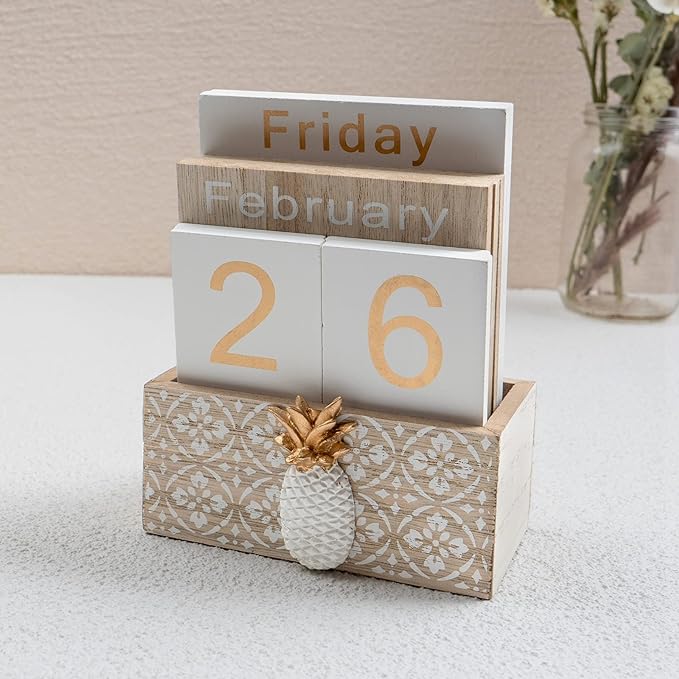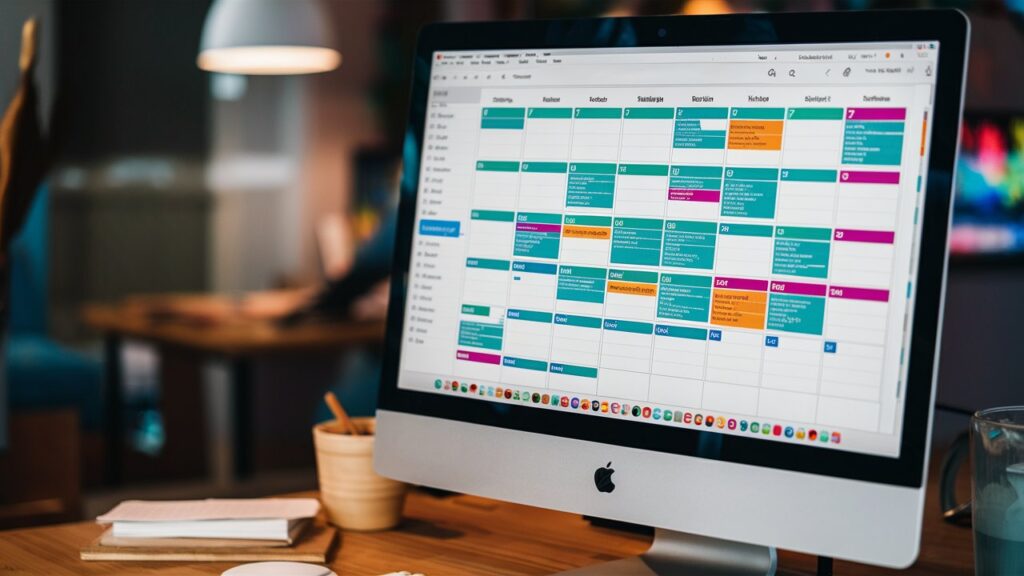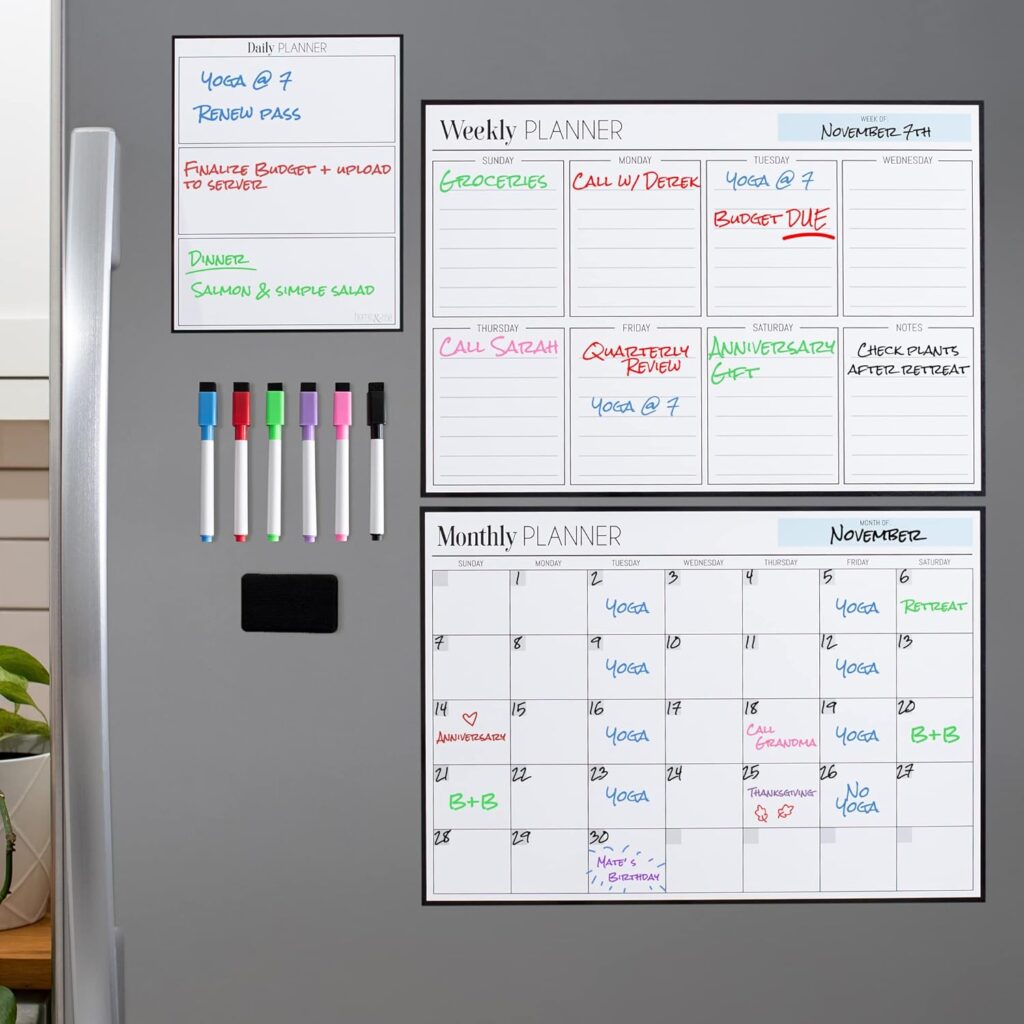Are you constantly overwhelmed by an endless to-do list and find yourself struggling to stay on top of your daily tasks? I’ve been there, and that’s where a block calendar has been a game-changer for me. A block calendar is an efficient scheduling method that involves dedicating large chunks of time to specific tasks, helping to improve time management, boost productivity, and reduce stress. In this article, I’ll dive into what makes block calendars such a productivity powerhouse, from their clear prioritization benefits to practical tips on how to implement them using both physical and digital tools.
Understanding Block Calendars: A Productivity Powerhouse
Feeling overwhelmed by daily tasks and struggling to stay organized is incredibly common but increasingly frustrating. Fortunately, block calendars offer a powerful solution designed to help you manage your time more effectively.
What is a Block Calendar?
A block calendar is a scheduling method where significant blocks of time are dedicated to specific tasks or activities. This approach helps you prioritize tasks, minimize distractions, and maximize productivity. By allocating specific time slots for particular tasks, you ensure that each task gets the attention it needs without interruptions or multitasking.
Benefits of Block Calendars
The advantages of using a block calendar are plentiful:
- Improved Time Management: You can allocate your time more efficiently, ensuring that each task is given the necessary attention.
- Increased Productivity: Focusing on one task at a time helps you complete tasks faster and with higher quality.
- Reduced Stress: A clear plan allows you to manage your workload better, reducing feelings of overwhelm.
- Enhanced Prioritization: You can identify the most important tasks and allocate your time accordingly.
How to Use a Block Calendar
Implementing a block calendar effectively involves several key steps.
Identify Your Tasks
Start by listing all the tasks you need to complete. Prioritize them based on importance and urgency. This helps in ensuring that high-priority tasks are not neglected.
Create Your Blocks
Divide your day into large blocks of time (e.g., two hours). Assign each block to a specific task. This way, you ensure that each task has a dedicated time slot.
Schedule Breaks
Don’t forget to include breaks between your blocks! These intervals are vital for recharging and avoiding burnout. A short break can make a huge difference in maintaining productivity throughout the day.
Stay Flexible
While it’s important to stick to your schedule, being too rigid can backfire. Be prepared to adjust if unexpected tasks arise. Flexibility ensures that your calendar remains a tool that aids rather than hinders your productivity.
Implementing a Block Calendar for Your Desk

Choosing the right tools and customizing them to fit your needs plays a big part in making this system work for you.
Choose Your Tool
Whether you prefer a physical planner, a digital calendar app, or even sticky notes, choose a tool that you find easy to use and access.
Customize Your Layout
Arrange your blocks to fit your specific needs and work style. This ensures that your calendar work for you, rather than you working for your calendar.
Make it Visual
Using colors, symbols, or icons can make your blocks more visually appealing and easier to read. Visual aids can significantly reduce the cognitive load needed to manage your schedule.
Review and Adjust
Regularly review your block calendar, making adjustments as needed to ensure it remains effective. Your schedule will evolve, and your calendar should evolve with it.
Conclusion
Block calendars are undeniably powerful tools for boosting productivity and managing time effectively. By dedicating specific blocks of time to specific tasks, you can stay focused, reduce stress, and achieve more. Regardless of whether you use a physical planner or a digital tool, incorporating block calendars into your daily routine can have a significant impact on your productivity and overall well-being.
Practical Applications
Now that you have a grasp on the basics, here’s how you can practically apply block calendaring in your life.
Choosing the Right Tool
First, let’s talk about tools. Here are three popular block calendar options that you might find useful:
- Juvale Wooden Perpetual Block Calendar for Desk: This rustic wooden block calendar features interchangeable date blocks, making it a great desk accessory for teachers, students, and home offices.
- Wooden Perpetual Desk Calendar: Made of high-quality wood, this simple yet elegant calendar has a compact design that fits nicely on any desk or tabletop.
- Rustic Desk Block Calendar: Featuring interchangeable wooden blocks for the date, day, week, and month, this farmhouse-style calendar is a versatile and decorative piece for both home and office.
How to Block Time in Your Outlook Calendar
If you’re using Outlook, blocking out time when you’re unavailable is straightforward. Here’s a simple step-by-step guide:
- Open Outlook Calendar: Start by opening your Outlook calendar.
- Create New Appointment: Click “New Appointment” to create a new event.
- Enter Details: In the appointment window, fill in the subject, location, and start/end times for when you’ll be out of the office.
- Show as Out of Office: Under the “Appointment” tab, select “Out of Office” from the “Show As” dropdown menu. This marks your calendar as busy during that time.
- All Day Event (Optional): If you’ll be out the entire day, check the “All Day Event” box.
- Set Recurrence: Click “Recurrence” to set the event to repeat daily, weekly, or on specific days if you’ll be out for multiple days.
- Save & Close: Finally, click “Save & Close” to block the time in your calendar.
This way, anyone viewing your calendar will see you are “Out of Office,” but they won’t see specific details of your event.
Block Calendar Examples

Here’s a practical example to help you visualize how to set up different types of block calendars.
Daily Block Calendar
| Time Block | Task |
|---|---|
| 8:00 AM – 10:00 AM | Project Work |
| 10:00 AM – 10:30 AM | Break |
| 10:30 AM – 12:30 PM | Client Meetings |
| 12:30 PM – 1:30 PM | Lunch |
| 1:30 PM – 3:30 PM | Administrative Tasks |
| 3:30 PM – 4:00 PM | Break |
| 4:00 PM – 6:00 PM | Continued Project Work |
Weekly Block Calendar
| Day | Morning | Afternoon |
|---|---|---|
| Monday | Project Planning | Team Meetings |
| Tuesday | Development Work | Administrative Tasks |
| Wednesday | Client Call | Continued Dev Work |
| Thursday | Testing & QA | Reports & Documentation |
| Friday | Review & Reflect | Planning Next Week |
In these examples, tasks are broken down into sizeable chunks of time, making it easier to manage the workload and stay focused.
Monthly Block Calendar
Since certain tasks or goals might span over several days or weeks, having a monthly block calendar can also be beneficial.
| Week | Focus |
|---|---|
| Week 1 | Strategic Planning |
| Week 2 | Implementation |
| Week 3 | Review & Adjustments |
| Week 4 | Final QA & Reporting |
I use the Cinch Magnetic Calendar Bundle on my fridge to help plan my day efficiently, with its three boards for monthly, weekly, and daily tasks, along with fine tip markers and magnets for easy organization.

Tips for Success
Being successful with block calendaring also involves a few subtle yet critical practices.
Consistency is Key
Maintaining a consistent schedule every day may sound boring, but it’s incredibly effective. Consistency helps build habits, making tasks almost second nature.
Keep a Buffer
Always keep some buffer time in your calendar to handle unexpected tasks or delays. This practice ensures you remain on track without becoming overwhelmed.
Prioritize Priority
Incorporate prioritization in your block calendar. Spending time on high-importance tasks first can significantly boost your productivity.
Leverage Technology
Take full advantage of digital tools and applications that can make blocking time easier. Tools like Google Calendar, Microsoft Outlook, or specialized apps like Todoist can be very handy.
Review Regularly
Make it a habit to review your calendar at the end of each week. This review can help you make necessary adjustments, ensuring your schedule remains as effective as possible.
Communicate Availability
In a work environment, ensure your team knows about your blocked time. This communication can save you from unnecessary interruptions.
Include Personal Time
Don’t just focus on work-related tasks; include blocks for exercise, hobbies, and relaxation. Balancing work and personal time is crucial for avoiding burnout.
Putting It All Together
So, how do you put all these elements together to create a block calendar that works for you? Let’s break it down into actionable steps:
- Identify Priorities: What are your most important tasks? Write them down.
- List Daily Tasks: Add all the tasks you need to accomplish daily.
- Create Time Blocks: Divide your day into blocks and assign the identified tasks to each block.
- Include Breaks: Schedule short breaks to maintain focus and energy.
- Review at End of Day: Spend a few minutes reviewing your day and adjusting blocks for the next day if needed.
- Weekly Review: At the end of each week, review your block calendar to see what worked and what didn’t, making necessary adjustments.
- Communicate with your Team: Ensure your team knows your blocked time and respects it.
Final Thoughts
Block calendaring is more than just a time management tool; it’s a way of life that can significantly improve your productivity and reduce stress. Whether you manage your schedule through a physical planner or a digital tool, the principles remain the same: prioritize, focus, and stay consistent.
By dedicating specific blocks of time to specific tasks, you give yourself the space to focus, get things done, and have time left over for the things you love. It’s all about finding a balance that works for you and sticking to it. So why not give it a try? The benefits are just a block away.
What is the basic concept of calendar?
A calendar is an organized set of days, weeks, and months arranged in a predetermined pattern that makes it simple to identify the necessary date, week, or month for a given day.
How to solve calendar questions easily?
The following details of calendar concepts are easy to recall: We get 5 odd days from 100 years, as we calculated above. We get 5 x 2 = 10 – 7 (one week) 3 odd days after 200 years. We get 5 x 3 = 15 – 14 (two weeks) + 1 odd day from 300 years.
Who made calendar first?
This model was created by the Romans, and Julius Caesar is credited with supervising the creation of the Julian Calendar and laying the groundwork for the modern calendar.




